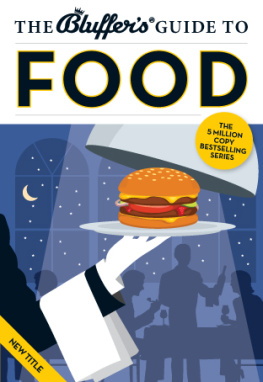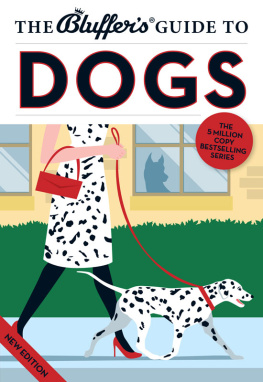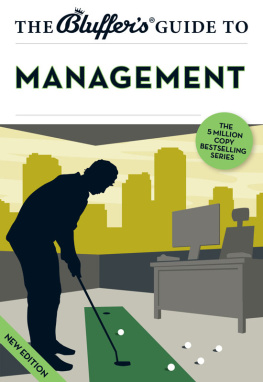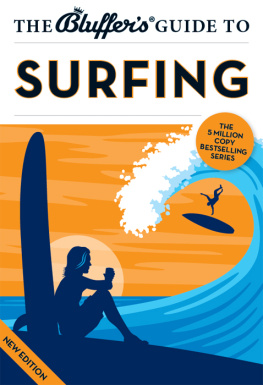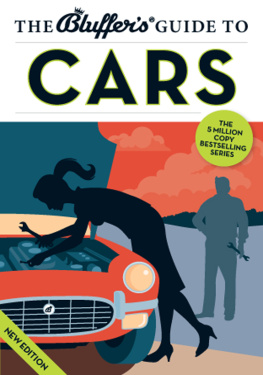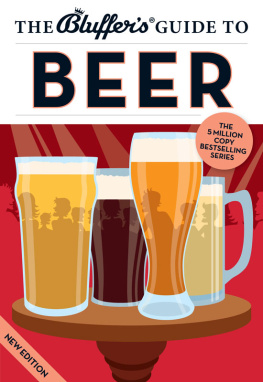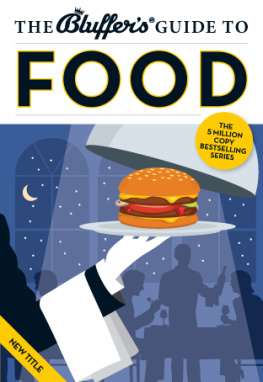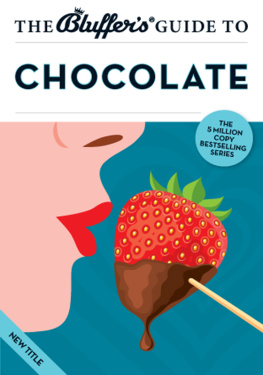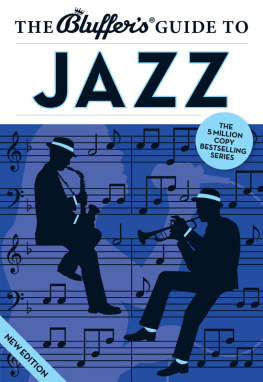Neil Davey - The Bluffers Guide to Food
Here you can read online Neil Davey - The Bluffers Guide to Food full text of the book (entire story) in english for free. Download pdf and epub, get meaning, cover and reviews about this ebook. year: 2014, publisher: Bluffers Guides (Perseus), genre: Home and family. Description of the work, (preface) as well as reviews are available. Best literature library LitArk.com created for fans of good reading and offers a wide selection of genres:
Romance novel
Science fiction
Adventure
Detective
Science
History
Home and family
Prose
Art
Politics
Computer
Non-fiction
Religion
Business
Children
Humor
Choose a favorite category and find really read worthwhile books. Enjoy immersion in the world of imagination, feel the emotions of the characters or learn something new for yourself, make an fascinating discovery.
- Book:The Bluffers Guide to Food
- Author:
- Publisher:Bluffers Guides (Perseus)
- Genre:
- Year:2014
- Rating:4 / 5
- Favourites:Add to favourites
- Your mark:
- 80
- 1
- 2
- 3
- 4
- 5
The Bluffers Guide to Food: summary, description and annotation
We offer to read an annotation, description, summary or preface (depends on what the author of the book "The Bluffers Guide to Food" wrote himself). If you haven't found the necessary information about the book — write in the comments, we will try to find it.
The Bluffers Guide to Food — read online for free the complete book (whole text) full work
Below is the text of the book, divided by pages. System saving the place of the last page read, allows you to conveniently read the book "The Bluffers Guide to Food" online for free, without having to search again every time where you left off. Put a bookmark, and you can go to the page where you finished reading at any time.
Font size:
Interval:
Bookmark:


Hammersley House
5-8 Warwick Street
London W1B 5LX
United Kingdom
Email:
Website: bluffers.com
Twitter:
Published 2014
Copyright Bluffers 2014
Publisher: Thomas Drewry
Publishing Director: Brooke McDonald
Series Editor: David Allsop
Design and Illustration: Jim Shannon
All rights reserved. No part of this publication may be reproduced, stored in a retrieval system or transmitted in any form or by any means, electronic, mechanical, photocopying, recording or otherwise, without the prior permission of Bluffers.
A CIP Catalogue record for this book is available from the British Library.
Bluffers Guide, Bluffers and Bluff Your Way are registered trademarks.
| ISBN: | 978-1-909937-12-3 (print) 978-1-909937-13-0 (ePub) 978-1-909937-14-7 (Kindle) |

You cant even take shelter in a library because theres a very good chance it will now be the site of a Malaysian/ Persian hybrid pop-up restaurant.

TO START
F ood is everywhere in the Western world, which is just as well because we wouldnt last long without it. But now it has gone far beyond its primary role as essential sustenance to become a central part of modern culture. These days its impossible to turn on the TV without stumbling across someone demonstrating a recipe, someone else screaming profanities about anothers culinary skills, or a large American man attempting to devour a hamburger the size of a small child.
And its not just TV. You cant pick up a newspaper or magazine without finding a celebrity telling you how to cook, a chef telling you how to eat or a supplement featuring a celebrity chef doing both. Pubs are becoming gastropubs, street vendors are opening restaurants and trained chefs are taking to the street. You cant even take shelter in a library because theres a very good chance it will now be the site of a Malaysian/Persian hybrid popup restaurant, a supper club or the location for a post-ironic tweed-clad street food collectives twist on the Wimpy burger.
Even sitting down to dinner with friends wont help. As you eat, conversations frequently turn to recollections of great meals youve had, where youve eaten recently, and what youve cooked this week. At the same time, you will be expected to analyse every bite of the food on your plate, listen to a detailed explanation of the cooking techniques involved and the precise sources of each individual ingredient, and plan where you should go for brunch tomorrow.
The rules have changed. Its no longer enough to be a food lover who once attempted something Keith Floyd cooked on TV. Now you have to be a food worshipper with a wealth of experience under your belt, a desire to analyse (and photograph) everything you consume (I know it looks like a slice of cheddar and a cream cracker, but its a deconstructed, scallion-drop, rustic cheese biscuit) and a depth of knowledge that could win you Mastermind. (And your specialist subject? Obscure world cuisine, 1800 to the present day.)
The subject of food is increasingly a minefield where, in order to survive with your credibility intact, you will be expected to know exactly whats being talked about when your dinner companions are discussing the relative merits of bo ssam and warabi-mochi or Korean pork in a lettuce leaf and a Japanese pudding made with bracken starch, if you prefer.
The days of just sitting back and having a pleasantly relaxed dinner are long gone. Food is to be studied and dissected as much as it is masticated and tasted. If that sounds like too much hard work, youre right. And thats why this book exists.
You may wonder why the term food worshipper is to be preferred to the ubiquitous foodie. The fact is that the people who get described as foodies loathe the word. The use of the term thus shows you up as a non-foodie, which is not the food bluffers objective.

Food worshipper suggests a level of cult devotion entirely appropriate to the world of food.

What better description might there be for these extreme lovers of food? Good question. So far, at the time of publication, no single universally adopted term has yet emerged. Food connoisseur is a bit pompous; food lover is perfectly acceptable, although it does leave the door open for jokes about inappropriate behaviour with chocolate eclairs. For the bluffer, however, connoisseur and lover dont quite cover the level of obsession you are about to encounter. Food worshipper, on the other hand, suggests a level of cult devotion entirely appropriate to the world of food.
You must also be loath to use the word passion. It is something you will hear a lot in food-based conversations, and must be avoided at all costs. You must never say, for example, Its so lovely to meet an artisan producer whos so passionate about what they do or so passionate about the welfare of their animals or so passionate about every other tiny aspect of their food business. If you want to eulogise about an artisan baker who is passionate about using only organic rice paper from a Vietnamese workers cooperative, then think of another word. Zealous or enthusiastic are good ones.
This is a fascinating and often complex world you are about to immerse yourself in, but, with the right guidance, your talent, and a grasp of facial expressions ranging from piety to insouciance, youre going to be fine. This short but definitive guide will conduct you through the main danger zones encountered in discussions about food, and equip you with a vocabulary and evasive technique that will minimise the risk of being rumbled as a bluffer. It will give you a few easily remembered nuggets of essential information that might even allow you to be accepted as a food expert of rare ability and experience. But it will do more. It will give you the tools to impress legions of marvelling listeners with your forensic knowledge of the subject without anyone discovering that, until you read it, you didnt know the difference between the sous vide method and the Maillard reaction.
Ladies and gentlemen. Bluffing is served
FOOD FOR THOUGHT
T he Cambridge World History of Food runs to several thousand pages and two shelf-threatening volumes. This chapter is going to attempt to cover much the same ground in approximately one-eleventh of a Bluffers Guide. Its a big task and one that is, frankly, unlikely to be easily accomplished.
However, dont lose heart. You will be relieved to discover that a comprehensive knowledge of food is not the bluffers way. Instead, your cunning strategy is to be armed with the salient points, to avoid too many questions and to be able to bring a conversation back to the subjects you do know.
The downside of the subject matter is its breadth. The advantage, therefore, is also its breadth. There is no shame in admitting that you dont know everything about food (How can you possibly know everything when there are so many world cuisines and so many regional variations within them?), provided that you know enough or can bluff enough around the gaps in your knowledge.
Next pageFont size:
Interval:
Bookmark:
Similar books «The Bluffers Guide to Food»
Look at similar books to The Bluffers Guide to Food. We have selected literature similar in name and meaning in the hope of providing readers with more options to find new, interesting, not yet read works.
Discussion, reviews of the book The Bluffers Guide to Food and just readers' own opinions. Leave your comments, write what you think about the work, its meaning or the main characters. Specify what exactly you liked and what you didn't like, and why you think so.

